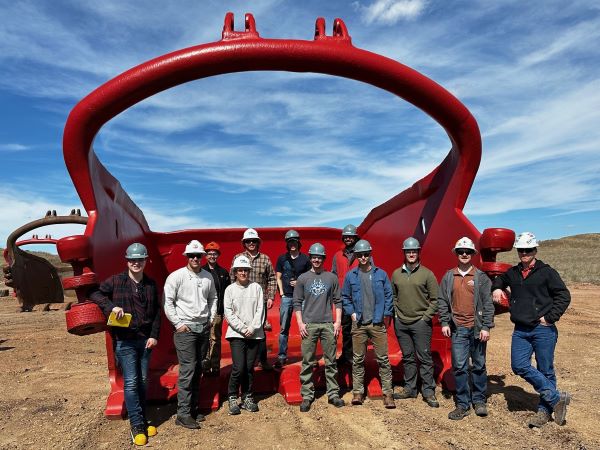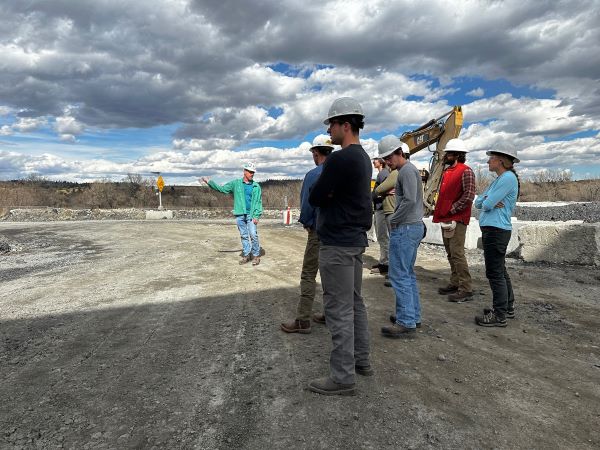Montana Tech students learn about environmental operations risks at three Montana industrial sites

Determination of risks – both threats and opportunities- and the ability to mitigate and manage them are fundamental aspects of being an engineer. One class that provides students the knowledge to evaluate risks posed to people, operational processes, and ecosystems is Dr. Robin Bullock’s Human Health, Environmental, and Operational Risk Management class at Montana Technological University.
“In the class, the students gain knowledge on what and how contaminants may impact individual’s health and the environment, as well as risks to communities and businesses through loss of control of facility hazards- such as high-pressure equipment and pipelines,” Bullock said. “Students also become aware of how non-environmental risks can also impact operations and communities through risks such as increased electricity costs, and loss of market for their products. Students develop multiple mitigation plans to then address their identified risks; As with anything, we want engineers to be part of not only identifying the risks/opportunities- but also be an integral part of developing solutions and implementing them.”

This spring semester students gained on-site knowledge from Montana Tech alumni at the Navajo Transitional Energy Corporation (NTEC) coal mine in Decker, the Sibanye Stillwater’s Columbus Metallurgical Complex, and the CHS petroleum refinery in Laurel.
At the NTEC Spring Creek Mine students met with Senior Environmental Engineering Gabe Johnson (Environmental Engineering, 1999) and Mining Engineering III David Lawson (Mining Engineering, 2015).
Gabe discussed the mining and reclamation steps, and how weather and timing impact re-seeding operations in the reclamation process.
“The class that toured was Risk Analysis, so we also discussed different risks to our business operation and risk analysis for working safely,” Johnson said.
Lawson focused on the equipment fleet and its purpose at the Spring Creek Mine.
“We emphasized the high level of environmental responsibility Spring Creek has and of the mining industry in general,” Lawson said.
At the CHS refinery, students met with Environmental Engineer Jessika Harman (Environmental Engineering, 2023), along with five other professionals, four of whom were Environmental Engineering graduates of Montana Tech. They included CHS Environmental Director Karen Kennah, Environmental Engineer George Fink, Environmental Engineer Kelda Gauer, and Environmental Engineer Caitlin Shanley. Technical Services Senior Director Tim Bonnet gave a talk on CHS’s future of sustainability during lunch.

The students learned about refining, environmental health and safety, air-related topics, the role of the environmental engineer at the refinery, and the wastewater treatment plant.
“It was really important to talk about what to expect after graduation,” Harman said. “Montana Tech does a really good job of preparing us for the working world, but there are a lot of things you can’t learn in the classroom. You may see a refinery, but you never realize how complicated it is until you are there.”
Harman interned at CHS her junior and senior years, which led to her taking a full-time position there, but other alumni focused on their journeys to the refinery, which included work in the pulp and paper, and chemical manufacturing industries.
“We wanted them to know you aren’t cemented to one thing with the environmental engineering degree,” Harman said. “There are so many career paths you can explore.”
Harman said the career path suits her.
“It’s always good to be looking to the future, and I think environmental engineering is a great way to help make the world a better place,” she said. “We’re really excited to give back to the students at Tech with so many of us being alumni. I am friends with all the students that came. It was great to meet the next generation of engineers.”
At Sibanye Stillwater’s Columbus Metallurgical Complex, students met with Environmental Compliance Manager Kevin Mitchum (Environmental Engineering, 1997).
Mitchum took time to explain how the Stillwater and East Boulder mines located near the towns of Nye and McLeod ship concentrate to the Metallurgical Complex in Columbus. The site also recycles up to 30% of spent automotive catalytic converters in the process feed with the mined concentrate. The target metals are platinum, palladium, and rhodium. Those metals have to be separated prior to also recovering copper and nickel at the site, before being shipped to another location for further refining. The Stillwater Mines are the only primary producers of palladium in the United States.
“Platinum and palladium are primarily used for catalytic converters, which help clean the air,” Mitchum said.
Mitchum also instructed students on how risks are assessed based on possible severity and consequences. The company then initiates action items to mitigate risks.
One of the tour’s highlights was the alkaline scrubbing system that scrubs sulfur dioxide produced in the refining process, significantly reducing the number of pollutants released from the complex.
“Our Air Quality Permit allows for 86 tons per year to be emitted, but we emitted less than 0.5 tons in 2023,” Mitchum explained.
The complex also has a limited amount of excess slag because of advancements in the refining process.
“We do not have a big slag pile because the slag we have from our furnaces is trucked back up to mine site to recover additional platinum and palladium, Mitchum said.
Overall, Mitchum wanted to educate students about why environmental engineers are important to the mining process.
“Mining is critical to our everyday lives, “Mitchum said. “We need to continue mining, recycling, and processing, and we can do it in an environmentally friendly way. All the work environmental engineers do is extremely important. As a company, we want to make sure we are in compliance, not only because it’s the law, but also because we enjoy living in Montana, and we as employees want to make sure the environment is kept clean.”